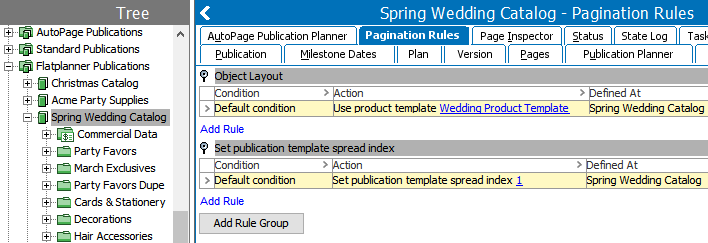A pagination rule is a rule that controls how, when, and where objects (typically products, but also assets and classifications) are added to a page.
A pagination rule consists of one or more conditions and an action that takes place if the condition is met. Detailed criteria must be specified for some conditions and actions. Through the use of pagination rules, many actions involved in the mounting of Flatplanner pages can be automated, such as the selection of publication template spread indexes and pre-selection of product templates for Flatplanner page frames.
Unlike Print AutoPage, pagination rules are optional for Print Flatplanner. However, they can be useful for reducing manual effort when building Flatplanner planned pages in STEP and mounting actual pages in InDesign.
For example, if a publication template stored in STEP is used to build Flatplanner pages in InDesign, pagination rules can be configured to pre-map a publication template spread (spread index) to each publication section, enabling users to automatically generate pages in InDesign using the correct spread. If publication templates are not used for page mounting and a mounting page is used instead, then users must first manually create blank pages from the desired master spread in InDesign before creating InDesign pages.
For object layouts, if a pagination rule is set on a publication or section to choose a 'default condition,' then all page frames within the publication or section will be automatically assigned the chosen product template. This avoids the need for manual linking of product templates to page frames. Layout rules can be further refined by assigning a specific product template to frames that meet specified conditions, such as which object type is linked to the frame or the object's placement on the page.
Pagination Rules Tab
Pagination rules are added on the Pagination Rules tab, which is available when a publication, section, or subsection is selected in the Tree.
The Pagination Rules tab provides an overview of all conditions and actions applied to the publication and/or section. You can also view where in the publication structure the rules are defined ('Defined At').

Adding Pagination Rules
For information on how to add pagination rules to publications, sections, or subsections, refer to the Adding Pagination Rules topic in the Publisher section of this guide here.
Pagination Rule Groups
Pagination rule groups are also known as Action Groups, since these groups contain selections of actions that should be taken on mounted objects and pages. Each group also contains an assortment of conditions that are applied to determine exactly how these actions will be carried out.
Two pagination rule groups are available in Flatplanner:
- Object layout
- Set publication template spread index
For detailed information on Flatplanner pagination rule groups and their available conditions and actions, refer to the Flatplanner Pagination Rule Groups, Conditions, and Actions topic here.
Pagination Rule Inheritance
Pagination rules are inherited by child sections from parent publications, and by child subsections from parent sections.
For more information, refer to the Pagination Rule Inheritance topic in the Publisher section of this guide here.
Pagination Rule Evaluation
Pagination rules are evaluated one-by-one in the list from top to bottom. When the condition of a rule evaluates to True, the associated action is then evaluated.
For more information, refer to the Pagination Rule Evaluation topic in the Publisher section of this guide here.
Editing Pagination Rules
For full details on how to edit pagination rules, refer to the Editing Pagination Rules topic in the Publisher section of this guide here.